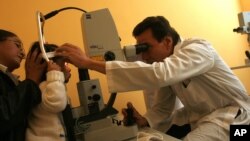Congenital cataracts are estimated to be responsible for between 5 and 20 percent of all cases of blindness in children worldwide.
Now scientists and doctors have discovered a new technique that not only removes the cataracts, but also stimulates a child's own stem cells to regrow a functioning lens, restoring vision more completely than ever before.
The results are reported in the online journal Nature.
The research was done by the University of California, San Diego School of Medicine and Shiley Eye Institute, with colleagues in China, and has been tested on animals and in a small human trial that showed impressive results.
Congenital cataracts occur at birth or soon after, and cause the lens of the eye to become cloudy. This keeps light from passing through the eye to the retina, and beyond to the brain.
Current treatment depends on the age of the patient and a host of other related complications. Surgery is often required, and almost all patients require corrective eyewear after cataract surgery.
The researchers tried a less invasive approach. The goal, they said, was not only to get rid of the cloudy lens, but to coax the body to use leftover stem cells to heal itself.
"An ultimate goal of stem cell research is to turn on the regenerative potential of one's own stem cells for tissue and organ repair and disease therapy," said Kang Zhang, founding director of the Institute for Genomic Medicine.
Less invasive approach
From birth, a person's eyes have a number of what scientists call lens epithelial stem cells or LECs. They live in the eye and generate replacement lens cells throughout a person's life, though production declines with age.
Current cataract surgeries remove almost all of these LECs, so they regenerate lens cells in a 'disorganized' way that doesn't help heal or reconstruct the actual lens.
So researchers combined a new surgical technique that is much less invasive and retains the shape of the lens, with a therapy that stimulates the LECs to grow.
They tried the technique on animals, and then in a small human trial of twelve infants.
Helping body heal itself
The results were impressive: All 12 patients had fewer complications post-surgery. They healed faster, and after three months, the LECs had rebuilt a clear, regenerated biconvex lens in the eyes of every patient.
"The success of this work represents a new approach in how new human tissue or organ can be regenerated and human disease can be treated, and may have a broad impact on regenerative therapies by harnessing the regenerative power of our own body," Zhang said.
With this success under their belt, the researchers are shifting their focus to older patients with age-related cataracts, which are the leading cause of blindness in the world.










